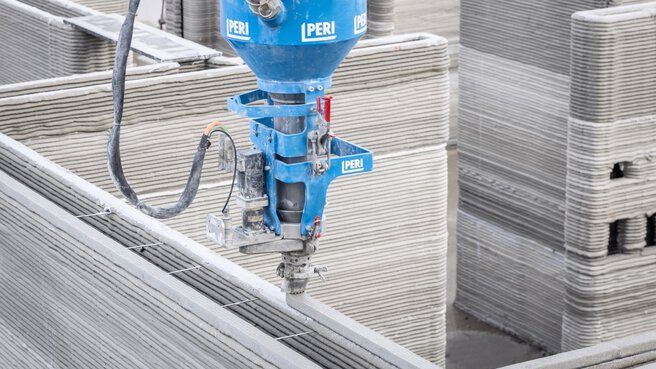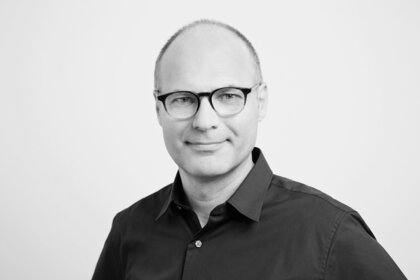“Additive manufacturing will change the market decisively”
Additive manufacturing—commonly referred to as 3D printing—was one of the leading topics at bauma 2022, the international construction machinery and building materials trade fair. In the following interview, scientist Prof. Dr.-Ing. Harald Kloft outlines the potential and status of this technology, which is classified as a megatrend throughout the industry.




Professor Kloft, you believe that additive manufacturing has the potential to fundamentally change the way we build in the future. Why?
Harald Kloft: In traditional construction processes, we spend a lot of time and energy creating individually shaped structures with system formwork or from standardized, industrially manufactured semi-finished products. In comparison, the digitally controlled, layer-by-layer material application of 3D printing is significantly more resource-efficient, economical, and ecological, because the material is only placed where it has a function. And the method is economical because virtually all manual work processes are eliminated. This certainly also has an impact on the professional world: with additive manufacturing, we need fewer but highly skilled workers. Finally, well thought out 3D printing has the potential to generate a new design language in the construction industry.
What is the “vocabulary” of this new design language?
Harald Kloft: Basically, 3D printing allows unprecedented freedom in shaping. However, a concrete extrusion printer, for example, 'wants' to work in a continuous, flowing line where possible. It appears relatively meaningless to want to print a rectangular building, as curves and roundings are more in line with the nature of the printing process. Here, I see future potential for disruptive design and architectural ideas that are more closely aligned with the forms of nature.
From the corporate side, who is driving the development of additive manufacturing methods in construction?
Harald Kloft: Classically, the market is divided into building material manufacturers, suppliers—such as from formwork or scaffolding construction—and companies that take over implementation on the
construction site. With additive manufacturing, these areas can no longer be seen separately: since the material is shaped in the printing process, material and printer form a symbiotic unit. It can be observed that technological development is currently mainly driven by new companies entering the market. These seem to find it easier than, for example, established building materials or precast manufacturers to embrace the innovations possible with 3D printing and build new business ideas.
What are currently the main obstacles and challenges that 3D printing has to overcome in the construction industry?
Harald Kloft: In terms of building regulations, the main issue is the lack of generally applicable standards and rules for the materials and processes used. Hence, at the moment, project-specific approvals are required when implementing 3D-printed construction projects.
Technologically, for example, intelligent solutions still need to be found for the integration of reinforcements and the finishing of the inhomogeneous surfaces associated with concrete pressure. The latter, however, could prove to be an ideal subsurface for a mechanical bond with plasters or insulating materials—ideally also applied additively, for example by a robot. The market will certainly find answers to these questions in the near future. The same applies to the question of what makes more sense in individual cases: 3D printing in the factory or directly on the construction site?
What's happening in the development of printable materials?
Harald Kloft: As already mentioned, new materials cannot be developed independently of the printing process. Currently, the focus is on more variance in the density of the material in terms of strength, insulating properties and weight. A certainly worthwhile goal for the future would also be the use of recycled concrete.
In which construction sectors do you think additive manufacturing will become established first?
Harald Kloft:One current pioneering project is the production of wind turbine tower bases using concrete 3D printing, driven by General Electric. Here, the wind turbine manufacturer is collaborating with construction group Lafarge Holcim and 3D printing specialist Cobod. The fact that the tower base is produced directly on the construction site eliminates the problem of transporting large-format components. Wind turbines of 200 meters height should become possible.
In such solutions, additive manufacturing can fully play to its technological strengths and enable new applications, while construction time, costs and material usage are the current drivers in residential construction. Here, Germany's first two 3D-printed apartment buildings by Peri/Cobod show that multi-family houses with three floors are already feasible. To establish concrete 3D printing in building practice, there is still a lot of research and development to be done. When the time comes, the use of 3D printers will likely be most efficient for four to six-story buildings.
The bottom line is that, for the foreseeable future, there will still be plenty of room for other technologies on construction sites. However, additive manufacturing will be a game changer.
About the interviewee:
Prof. Dr.-Ing. Harald Kloft heads the Institute of Structural Design (ITE) at the TU Braunschweig. In this role, he is also the spokesperson for the Collaborative Research Center TRR 277 “Additive Manufacturing in Construction—the Challenge of Large Scale” which is funded by the German Research Foundation (DFG) and began its work in early 2020.

